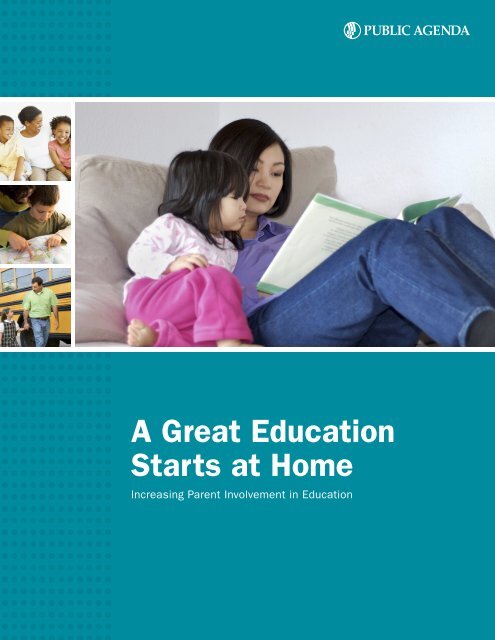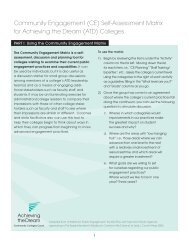A Great Education Starts at Home - Public Agenda
A Great Education Starts at Home - Public Agenda
A Great Education Starts at Home - Public Agenda
You also want an ePaper? Increase the reach of your titles
YUMPU automatically turns print PDFs into web optimized ePapers that Google loves.
A <strong>Gre<strong>at</strong></strong> <strong>Educ<strong>at</strong>ion</strong><br />
<strong>Starts</strong> <strong>at</strong> <strong>Home</strong><br />
Increasing Parent Involvement in <strong>Educ<strong>at</strong>ion</strong>
A <strong>Gre<strong>at</strong></strong> <strong>Educ<strong>at</strong>ion</strong><br />
<strong>Starts</strong> <strong>at</strong> <strong>Home</strong><br />
Increasing Parent Involvement in <strong>Educ<strong>at</strong>ion</strong><br />
Introduction<br />
If there’s one thing th<strong>at</strong> just about everyone involved in<br />
educ<strong>at</strong>ion agrees on, it’s th<strong>at</strong> when parents are actively<br />
and constructively involved in their children’s educ<strong>at</strong>ion<br />
it can make a very big difference in how well students<br />
do in school. Parents (or grandparents or guardians)<br />
are not only their children’s first teachers, they are the<br />
only teachers kids have throughout their entire childhood.<br />
Meanwhile schoolteachers must contend with<br />
large classes and tight budgets, meaning they simply<br />
cannot give every child the kind of individualized<br />
<strong>at</strong>tention th<strong>at</strong> would be ideal. Research tells us th<strong>at</strong><br />
schools th<strong>at</strong> have a lot of parent involvement are<br />
frequently more successful than those th<strong>at</strong> don’t.<br />
These are just some of the reasons why it’s so<br />
important th<strong>at</strong> parents or guardians play a major<br />
role in supporting their children’s educ<strong>at</strong>ion.<br />
Unfortun<strong>at</strong>ely, not enough parents are meaningfully<br />
involved in our community, and our children are<br />
suffering as a result.<br />
Low parent involvement can be caused by a number<br />
of things, including:<br />
• Poor communic<strong>at</strong>ion between teachers and parents<br />
about wh<strong>at</strong> their children are studying and how well<br />
they are doing.<br />
• Households in which parents are working multiple<br />
jobs to make ends meet, or in which other<br />
obstacles or problems make it hard for parents<br />
to be actively involved.<br />
• Parents who are not aware of the most important<br />
things they can do, from preschool through high<br />
school, to help their children succeed in school.<br />
• Parents who feel intimid<strong>at</strong>ed by or unwelcome<br />
<strong>at</strong> the schools.<br />
Today’s convers<strong>at</strong>ion is about understanding the<br />
obstacles to parent involvement in our community<br />
and finding str<strong>at</strong>egies and ideas th<strong>at</strong> will increase<br />
parent involvement and help students succeed.<br />
To help focus our discussion in the most productive<br />
way possible, let’s assume th<strong>at</strong> some parents are<br />
already very involved in their children’s educ<strong>at</strong>ion and<br />
therefore do not need special <strong>at</strong>tention, while others<br />
have so many personal problems th<strong>at</strong> they will probably<br />
never be as involved in their children’s educ<strong>at</strong>ion as we<br />
would like.<br />
Let’s also assume th<strong>at</strong> most parents do not fall into<br />
either of these c<strong>at</strong>egories, meaning there’s a large<br />
middle group of parents who are not as involved as<br />
they could or should be but who might become more<br />
involved with the right kind of inform<strong>at</strong>ion, opportunities,<br />
and support. Today’s convers<strong>at</strong>ion will focus primarily<br />
on this middle group of parents and wh<strong>at</strong> we can do to<br />
increase their involvement.<br />
With this as our starting point, the question is: Wh<strong>at</strong><br />
can we do in our schools and community to inspire and<br />
help more parents to become more involved in their<br />
children’s educ<strong>at</strong>ion<br />
To help you and your neighbors think and talk about this<br />
important topic, this guide describes three different<br />
approaches to increasing and improving parent involvement.<br />
Which approach, or combin<strong>at</strong>ion of approaches, is<br />
the best fit for your community and promises to have the<br />
gre<strong>at</strong>est impact<br />
As we consider our options, we should keep in mind th<strong>at</strong><br />
we cannot do everything <strong>at</strong> once and will have to set<br />
priorities—better to do a few things well than to do many<br />
things poorly. Wh<strong>at</strong> should our priorities be as we work<br />
to improve parent involvement in our local schools<br />
1 | A <strong>Gre<strong>at</strong></strong> <strong>Educ<strong>at</strong>ion</strong> <strong>Starts</strong> <strong>at</strong> <strong>Home</strong>: Increasing Parent Involvement After in <strong>Educ<strong>at</strong>ion</strong> the Bell: Wh<strong>at</strong> Do We Want Our Afterschool Programs to Do | B
Approach A:<br />
Have high expect<strong>at</strong>ions of parents and educ<strong>at</strong>e them<br />
about the most important ways they can help their<br />
children succeed in school<br />
Years ago, when many of today’s parents were growing up, the critical role th<strong>at</strong> parents could play in helping children<br />
succeed in school was not as well understood as it is today. As a result, many of today’s parents were not raised by<br />
strongly involved parents and simply do not know all the things they can and should be doing to help their kids<br />
succeed in school.<br />
Therefore, we should do things like:<br />
• Strongly encourage parents to meet with teachers,<br />
in person or by phone, <strong>at</strong> the beginning of the<br />
school year to review m<strong>at</strong>erials sent to them<br />
about wh<strong>at</strong> their children are expected to<br />
learn in every course.<br />
• Provide parents with simple checklists throughout<br />
the year with inform<strong>at</strong>ion about the most important<br />
ways they can help their children succeed<br />
in school.<br />
• Make sure there is good communic<strong>at</strong>ion between<br />
teachers and parents throughout the school year<br />
(and not just <strong>at</strong> the end) about how well students<br />
are doing.<br />
Those who like this approach say:<br />
“Parents do not magically know wh<strong>at</strong> they can do to<br />
support their children’s educ<strong>at</strong>ion. The schools and<br />
community should do a much better job of providing<br />
parents with inform<strong>at</strong>ion about how they can help<br />
their children succeed.”<br />
But others say:<br />
“Providing inform<strong>at</strong>ion and training is not enough.<br />
We’ve got to break down the barriers between many<br />
schools and parents.”<br />
• Provide adult-educ<strong>at</strong>ion opportunities to help<br />
parents learn skills th<strong>at</strong> will assist them in<br />
helping their children, such as computer skills,<br />
adult literacy, and homework help tutorials.<br />
A <strong>Gre<strong>at</strong></strong> <strong>Educ<strong>at</strong>ion</strong> <strong>Starts</strong> <strong>at</strong> <strong>Home</strong>: Increasing Parent Involvement in <strong>Educ<strong>at</strong>ion</strong> | 2
Approach B:<br />
Break down the barriers between schools and parents<br />
For a variety of reasons having to do with history, language, culture, and group rel<strong>at</strong>ions, many parents in our<br />
community may not feel connected to the schools and even the larger community in which they live. They<br />
may be intimid<strong>at</strong>ed by talking to teachers, assume they’re not welcome, or have neg<strong>at</strong>ive memories of their<br />
own school experience, and this can be a major obstacle to their becoming more involved in their<br />
children’s educ<strong>at</strong>ion.<br />
Therefore, we should do things like:<br />
• Make sure the schools are welcoming and helpful<br />
to all parents, with convenient parking, clear signs<br />
showing where things are, and friendly, welltrained<br />
staff.<br />
• Transl<strong>at</strong>e school inform<strong>at</strong>ion into the languages<br />
th<strong>at</strong> parents may speak <strong>at</strong> home with their<br />
children, and schedule meetings <strong>at</strong> times<br />
convenient for residents with different<br />
kinds of work schedules.<br />
Those who like this approach say:<br />
“Many parents in our community are disconnected<br />
from the schools, and we need to do more to make<br />
them feel welcome and connected if we want them<br />
to be more involved.”<br />
But others say:<br />
“The schools are already busy just trying to educ<strong>at</strong>e kids.<br />
Should they really be spending time and resources on<br />
these sorts of efforts”<br />
• Make special efforts to reach uninvolved parents<br />
through home visits by teachers, parent-to-parent<br />
support groups, or other innov<strong>at</strong>ive str<strong>at</strong>egies.<br />
• Hold community-wide celebr<strong>at</strong>ions and cultural<br />
festivals <strong>at</strong> the schools and provide family health<br />
services and fitness classes on school grounds, so<br />
th<strong>at</strong> the schools become centers of community life.<br />
3 | A <strong>Gre<strong>at</strong></strong> <strong>Educ<strong>at</strong>ion</strong> <strong>Starts</strong> <strong>at</strong> <strong>Home</strong>: Increasing Parent Involvement in <strong>Educ<strong>at</strong>ion</strong>
Approach C:<br />
Leave parent involvement to parents so th<strong>at</strong><br />
the schools can concentr<strong>at</strong>e on teaching<br />
The schools should not be spending energy and resources on getting parents involved, which is something parents<br />
should be doing anyway. And they certainly shouldn’t be using low parent involvement as an excuse for low<br />
student achievement.<br />
Instead, the schools should focus on teaching students successfully, whether parents are involved or not. This means<br />
concentr<strong>at</strong>ing on things like teacher quality and curriculum. And it means providing support th<strong>at</strong> compens<strong>at</strong>es for<br />
the fact th<strong>at</strong> some parents are not able or willing to be as involved in their children’s educ<strong>at</strong>ion as we’d like.<br />
Therefore, we should do things like:<br />
• Direct energy and resources th<strong>at</strong> would have<br />
gone toward parent outreach to improving<br />
teacher training and developing a more<br />
effective curriculum.<br />
• Provide more services <strong>at</strong> school for those kids who<br />
are not getting their needs met <strong>at</strong> home, such as<br />
nutritious meals <strong>at</strong> the beginning and end of the<br />
day (and not just <strong>at</strong> lunch), medical checkups,<br />
and social services.<br />
Those who like this approach say:<br />
“Schools should focus on their primary mission of<br />
teaching <strong>at</strong> school r<strong>at</strong>her than trying to get parents<br />
to do things they ought to be doing anyway.”<br />
But others say:<br />
“Not only is parent involvement too important to<br />
ignore, the more we increase it the less we’ll need<br />
to spend on expensive programs to compens<strong>at</strong>e for<br />
parents who are missing.”<br />
• Cre<strong>at</strong>e tutoring and mentoring programs through<br />
community volunteers or student peer groups to<br />
make up for uninvolved parents, so th<strong>at</strong> all kids<br />
have the extra help, encouragement, and role<br />
models they need.<br />
• Provide safe, healthy, and productive places for kids<br />
to spend their free time before school starts and<br />
after school lets out.<br />
A <strong>Gre<strong>at</strong></strong> <strong>Educ<strong>at</strong>ion</strong> <strong>Starts</strong> <strong>at</strong> <strong>Home</strong>: Increasing Parent Involvement in <strong>Educ<strong>at</strong>ion</strong> | 4
The Choices in Brief<br />
Approach A:<br />
Have high expect<strong>at</strong>ions of<br />
parents and educ<strong>at</strong>e them<br />
about the most important<br />
ways they can help their<br />
children succeed in school<br />
Therefore, we should<br />
do things like:<br />
• Strongly encourage parents to<br />
meet with teachers, in person or<br />
by phone, <strong>at</strong> the beginning of the<br />
school year to review m<strong>at</strong>erials<br />
sent to them about wh<strong>at</strong> their<br />
children are expected to learn in<br />
every course.<br />
• Provide parents with simple<br />
checklists throughout the<br />
year with inform<strong>at</strong>ion about<br />
the most important ways<br />
they can help their children<br />
succeed in school.<br />
• Make sure there is good communic<strong>at</strong>ion<br />
between teachers and<br />
parents throughout the school<br />
year (and not just <strong>at</strong> the end)<br />
about how well students are<br />
doing.<br />
• Provide adult-educ<strong>at</strong>ion opportunities<br />
to help parents learn<br />
skills th<strong>at</strong> will assist them in<br />
helping their children, such as<br />
computer skills, adult literacy,<br />
and homework help tutorials.<br />
Approach B:<br />
Break down the<br />
barriers between<br />
schools and parents<br />
Therefore, we should<br />
do things like:<br />
• Make sure the schools are<br />
welcoming and helpful to<br />
all parents, with convenient<br />
parking, clear signs showing<br />
where things are, and friendly,<br />
well-trained staff.<br />
• Transl<strong>at</strong>e school inform<strong>at</strong>ion into<br />
the languages th<strong>at</strong> parents may<br />
speak <strong>at</strong> home with their<br />
children, and schedule<br />
meetings <strong>at</strong> times convenient<br />
for residents with different<br />
kinds of work schedules.<br />
• Make special efforts to reach<br />
uninvolved parents through<br />
home visits by teachers, parentto-parent<br />
support groups, or<br />
other innov<strong>at</strong>ive str<strong>at</strong>egies.<br />
• Hold community-wide celebr<strong>at</strong>ions<br />
and cultural festivals <strong>at</strong> the<br />
schools and provide family health<br />
services and fitness classes on<br />
school grounds, so th<strong>at</strong> the<br />
schools become centers of<br />
community life.<br />
Approach C:<br />
Leave parent involvement to<br />
parents so th<strong>at</strong> the schools<br />
can concentr<strong>at</strong>e on teaching<br />
Therefore, we should<br />
do things like:<br />
• Direct energy and resources th<strong>at</strong><br />
would have gone toward parent<br />
outreach to improving teacher<br />
training and developing a more<br />
effective curriculum.<br />
• Provide more services <strong>at</strong> school<br />
for those kids who are not<br />
getting their needs met <strong>at</strong> home,<br />
such as nutritious meals <strong>at</strong> the<br />
beginning and end of the day<br />
(and not just <strong>at</strong> lunch), medical<br />
checkups, and social services.<br />
• Cre<strong>at</strong>e tutoring and mentoring<br />
programs through community<br />
volunteers or student peer groups<br />
to make up for uninvolved<br />
parents, so th<strong>at</strong> all kids have the<br />
extra help, encouragement, and<br />
role models they need.<br />
• Provide safe, healthy, and<br />
productive places for kids<br />
to spend their free time<br />
before school starts and<br />
after school lets out.<br />
5 | A <strong>Gre<strong>at</strong></strong> <strong>Educ<strong>at</strong>ion</strong> <strong>Starts</strong> <strong>at</strong> <strong>Home</strong>: Increasing Parent Involvement in <strong>Educ<strong>at</strong>ion</strong>
A Note on <strong>Public</strong> <strong>Agenda</strong>’s<br />
Choicework Discussion Guides<br />
<strong>Public</strong> <strong>Agenda</strong>’s Choicework Discussion Guides support dialogue and deliber<strong>at</strong>ion on a wide variety of issues. They<br />
have been used in thousands of community convers<strong>at</strong>ions, discussion groups, and classrooms and by journalists,<br />
researchers, policy makers, community leaders, and individuals looking to better understand and discuss solutions<br />
to a variety of public and community issues.<br />
Each guide is organized around several altern<strong>at</strong>ive ways of thinking about an issue, each with its own set of values,<br />
priorities, pros, cons, and trade-offs. The different perspectives are drawn both from how the public thinks about an<br />
issue as well as wh<strong>at</strong> experts and leaders say about it in policy deb<strong>at</strong>es. Users of the guides should be encouraged<br />
to put additional ideas on the table or consider combining elements from different choices in unique ways. They are<br />
designed as a starting point for constructive dialogue and problem-solving.<br />
Using this guide in a community convers<strong>at</strong>ion,<br />
discussion group, or classroom setting<br />
After discussing the choices, it can be helpful to first summarize the convers<strong>at</strong>ion<br />
and then bridge to action-oriented deliber<strong>at</strong>ions, as follows:<br />
Summarizing a Choicework Convers<strong>at</strong>ion<br />
These questions are a good way to summarize a<br />
Choicework convers<strong>at</strong>ion, prior to considering more<br />
action-oriented questions.<br />
1. In our convers<strong>at</strong>ion so far, have we discovered<br />
any common ground Wh<strong>at</strong> do we agree on or<br />
have in common<br />
2. Wh<strong>at</strong> were our important areas of disagreement—<br />
the issues we may have to keep talking about in<br />
the future<br />
3. Wh<strong>at</strong> are the questions and concerns th<strong>at</strong> need<br />
more <strong>at</strong>tention Are there things we need more<br />
inform<strong>at</strong>ion about<br />
Bridging from Dialogue to Action<br />
These questions can help you move from dialogue<br />
about the issue <strong>at</strong> hand to actions th<strong>at</strong> can help address<br />
the issue.<br />
1. How can we work together to make<br />
a difference in our community on<br />
the issues we discussed today This is<br />
a brainstorming phase of the discussion.<br />
2. Among the action ideas we’ve discussed, how<br />
should we prioritize them<br />
3. How should we follow up on today’s convers<strong>at</strong>ion<br />
Are there individual steps we can make Are there<br />
things we can do collectively<br />
After the Bell: Wh<strong>at</strong> Do We Want Our Afterschool Programs to Do | 5
About <strong>Public</strong> <strong>Agenda</strong><br />
<strong>Public</strong> <strong>Agenda</strong> is a nonpartisan, nonprofit research and public engagement organiz<strong>at</strong>ion. We work<br />
to ensure th<strong>at</strong> the public has the best possible conditions and opportunities to engage thoughtfully<br />
in public life and th<strong>at</strong> decision-making by leaders is well-informed by people’s values, ideas, and<br />
aspir<strong>at</strong>ions. Our programs aim to inform public policy, strengthen communities, and empower citizens.<br />
Want to Learn More<br />
Want to find out more about <strong>Public</strong> <strong>Agenda</strong>’s distinct approach to improving public life Interested<br />
in connecting with other citizens to address critical issues If so, you can check out our online<br />
community and sign up to find out about activities th<strong>at</strong> bring people together to strengthen their<br />
communities. Email us <strong>at</strong> publicengagement@publicagenda.org. You can also keep in touch by<br />
becoming a fan on Facebook or by following us on Twitter @<strong>Public</strong><strong>Agenda</strong>.<br />
Copyright © 2010 <strong>Public</strong> <strong>Agenda</strong><br />
This work is licensed under the Cre<strong>at</strong>ive Commons Attribution-noncommercial-Share Alike 3.0 Unported license<br />
To view a copy of this license, visit http://cre<strong>at</strong>ivecommons.org/licenses/by-nc-sa/3.0/ or send a letter to<br />
Cre<strong>at</strong>ive Commons, 171 Second Street, Suite 300, San Francisco, California 94105, USA<br />
<strong>Public</strong> <strong>Agenda</strong><br />
6 East 39th Street<br />
New York, NY 10016<br />
t (212) 686.6610 f (212) 889.3461<br />
www.<strong>Public</strong><strong>Agenda</strong>.org<br />
After the Bell: Wh<strong>at</strong> Do We Want Our Afterschool Programs to Do | 6






